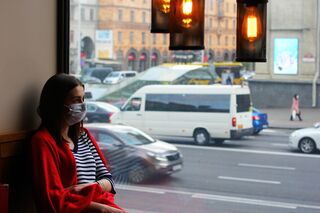Beauty
4 Powerful Techniques to Banish the Lockdown Body Blues
Discover a beautiful new you, no matter your dress or pants size.
Posted December 5, 2020

Quick—what are the first words that come to your mind when I say, “Think about your body”? Did “fat” or “out-of-shape” or some variation thereof pop into your mind? So many of us have spent this lockdown and quarantine time eating away, not exercising, and slowly packing on the pounds!
You are definitely not alone in feeling the lockdown body blues. Studies around the world have shown that stress-related depression and anxiety disorders have spiked during the COVID-19 lockdown.1
Joanne, a 40-something single paralegal has been working from home and mindlessly munching away on candy and pretzels for months. Joanne got to the point where she was afraid to step on the scale. Her pants did not even fit for the last few weeks. Joanne’s mood plummeted as she contemplated losing what looked to be at least an additional 30 pounds. Feeling hopeless, she did not even begin to start any diet or exercise program.
The heavy truth is that when we women relate to our appearance we are almost always in a judgmental, critical, and PICKY mode. We view our bodies through a distorted lens, so that each pound seems to be 10, each dimple of cellulite is like a sea of orange-peel skin, each wrinkle is like a crevice that draws all the attention. This happens because we unconsciously use a compare and despair function, in which we compare ourselves to impossible-to-achieve size zero, 20-something ideals of beauty. This is especially true during lockdown as we binge-watch shows and stay glued to social media. Ads, TV, movies, and even social media blast out these images of thinness, youth, and perfect airbrushed beauty on a daily basis. And lockdown keeps us trapped and facing all that comforting food.
No one has a perfect body. Those photos you see of celebs in magazines are retouched. Those actors in movies and on TV are layered in makeup and have body doubles half the time. Those models you see on the runways are usually struggling with eating disorders that can have them looking like skeletons in real life. The obsession with being thin, young, and perfect-looking is the bane of our culture. If you have ever felt bad about your body—like you have too much cellulite, too many wrinkles, and too many pounds, eyesore pimples, dandruff, a small chest, fat legs, or ugly toes—you are not alone. Every woman in this culture suffers from what I call the body blues at some point in their adolescent and adult lives. Especially now!
So we often compare and despair about never looking good enough. It is a very vicious, no-win trap, and it operates both unconsciously and consciously. It has been wired into our brains’ neural networks, which makes it very hard to change. And with that depressive feeling, it is very hard to start new eating or exercise habits—habits that will bring you back to your old slim figure or take you into even better shape than at the beginning of the pandemic.
But you can break this cycle of feeling fat, then feeling resigned and hopeless about changing your body and your mood! It starts with changing the way you are feeling about your body right now. You can use what I call Body-Love work to help you be at home physically, feel confident about your appearance, and relish your body, no matter what your current size.
You could actually love the way you look—extra pounds, dimpled thighs and all! How? By reshaping your brain’s neural networks for how you perceive yourself physically and emotionally. That's right, giving yourself a new identity by practicing four simple exercises. And I don't mean pushups or squats.
You will be more at home and open sensually and sexually (which makes you more irresistible). You will be able to have more intimacy, pleasure, and connection when you want it, whether you are dating a promising new guy or have been married for many decades. With this new identity, you can overcome any body-based shame or body blues you may have been struggling with.
I can only imagine what body issues Salma Hayek was struggling with, but trust me, she was. Here is a powerful quote from her:
“People often say that ‘beauty is in the eye of the beholder,’ and I say that the most liberating thing about beauty is realizing that you are the beholder. This empowers us to find beauty in places where others have dared not to look, including inside ourselves.”
As Salma realized, our perception of our own beauty/thinness/fatness lies in recognizing that we own the lens to focus on what we behold. Not anyone else. So if you give yourself a body image makeover it will give you, the beholder, A NEW PAIR OF GLASSES. That’s right: a new pair of glasses. But first, you have to throw away the old pair that caused you so much suffering.
Body Love Makeover
You can break out of your negative body image trap by changing this habitual and judgmental thought pattern. This allows your brain to rewire the neural network that keeps you prisoner to negative judgments about your appearance. And from this new point of view, it will be much easier to create a healthier diet, exercise or make changes that serve you on a physical level.
Here are four powerful exercises to create a body love makeover:
1. The Miracle Mirror Exercise
For this powerful exercise, wear form-fitting but not revealing clothing and stand in front of the mirror. As you look in the mirror pick three to five things that you like about your physical appearance. When practiced regularly, this exercise will shift the focus away from your insecurities and onto the physical features that you do appreciate. You have to admit you have sexy feet. That the shape of your breasts is kind of nice. That the curve of your shoulder has a certain beauty to it.
As you look in the mirror, mentally send unconditional love to each of the body parts you admire. Then send unconditional love to your whole body and your face. Think, I send you love! In fact, research shows that looking into a mirror can help correct body image issues.2
2. Help Your Body Sing with Gratitude
Here is another powerful way to break out of your negative body image thoughts and make your body feel good and healthy. Make a gratitude list about your body. It’s been shown that the counting of one’s blessings leads to less depression and an elevated mood. Feeling gratitude toward your body is doubly powerful in this regard because it throws a monkey wrench into your usual barrage of attack thoughts. So I want you to literally send yourself an e-mail that is a gratitude list about your body. Here is an example of one of mine, which I sent even though I had packed on some lockdown weight:
Dearest Body,
Thanks for keeping me healthy! And breathing so well!
I love the way you are working to digest food for me.
Thanks for my beautiful and acute vision.
My toes are awesome.
Immense gratitude for my strong immune system.
Thanks for immediately letting me know when I eat too much.
Love my long fingers and being able to type fast and write books.
All my love,
Diana
PS—It really felt great writing that!
3. Discovering the Beauty of Your Face
Chances are you have never really seen your face. You have missed the symmetry, the sparkle that comes from the depths of your eyes, the way your eyebrows frame those eyes. The little crinkles of pure happiness that come from your mouth when you giggle or laugh out loud. Imagine looking at your face as a good archetypal mother or a perfectly loving partner would see it. This is a very important Body Love exercise.
Every day before you brush your teeth, spend three minutes really looking at your face in the mirror. Look for beauty. Look for character. Look for the twinkle, the sparkle of your soul. Look at the person in the mirror as if you have just fallen in love with her. What do you notice? Do you see how your beloved you changes from day to day? Do you see the absolute perfection of the imperfections in that face?
The ineffable presence of consciousness that is deep in the eyes? Keep looking—it is all there.
4. Luscious You: The Chocolate Cake Exercise
OK, so you have countered your body image war stories and noticed what is beautiful about your body and your face in the mirror. Great work! I celebrate your progress. Now we will work on you getting your sensual, sexy body image back (or feeling it for the first time). Here is an exercise developed by one of my awesome coaches, Susan Kalinowski, called the Chocolate Cake Exercise. First think about your favorite dessert and write about eating it and savoring every bite. There is a sensual and adoring quality in that yummy experience. You can feel the power of the crème brûlée or Vanilla Swiss Almond ice cream.
Now imagine you are in a social situation and you are that incredible, desirable, alluring, satisfying dessert, just sitting there on the counter. There is a smile, a confidence, a self-prizing look, as on the cat that swallowed the canary. This is a place where you toss your head and raise your eyebrows as if to say, “Mmmm, I am delicious ...” A sensuality naturally exists in all of us that has the ability to emerge through the power of thinking you are the dessert.
I love this exercise. And I practice it myself when my husband and I make a romantic dinner at home. It definitely leads to a yummy over-the-top evening!
Our coaching client Joanne did all four of these body love exercises and began to turn her depression about her lockdown weight gain around. As she grew more self-loving, she gave herself a new nickname, Voluptuous Love. And Joanne was able to go online and start socially distanced dating. With her new attitude towards herself, she even started a keto weight-loss diet that is boosting her mood even further!
So go ahead and play with these four exercises—you too can beat the lockdown body blues!
References
1 Rodolfo Rossi, Valentina Socci, et al. COVID-19 pandemic and lockdown measures impact on mental health among the general population in Italy. An N=18147 web-based survey. medRxiv 2020.04.09.20057802; doi: https://doi.org/10.1101/2020.04.09.20057802
2Delinsky, S.S. and Wilson, G.T. (2006), Mirror exposure for the treatment of body image disturbance. Int. J. Eat. Disord., 39: 108-116. https://doi.org/10.1002/eat.20207




